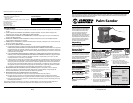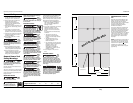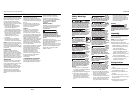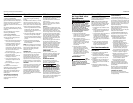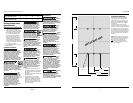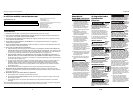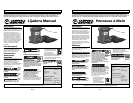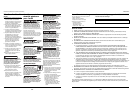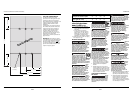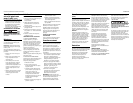
DG480100CK
19 Sp
DIMENSIONES DEL PAPEL DE
LIJA
El tamaño de la almohadilla de esta
lijadora manual es ligeramente más
grande de aquel de una lijadora
manual tradicional. Si el usuario desea
cortar su propio papel de lija,
el diagrama ilustrado indica las
dimensiones necesarias.
Si el usuario desea usar el sistema de
recolección de polvo que viene con
esta lijadora, es necesario perforar los
orificios en las ubicaciones indicadas.
Un manera fácil de perforar esos
orificios es ayudándose con un lapicero
o perforar con un taladro. En ambos
casos, la perforación de los orificios
debe empezar por el lado arenoso
del papel.
NOTA: La ilustración a la izquierda ha
sido reducida en tamaño para poder
inserirla en este manual. NO
use esta
ilustración como patrón. Las medidas
indicadas son correctas y pueden
usarse cuando desee cortar su propio
papel de lija.
6.3” (160mm)
0.25” (6mm)
(6 ubicaciones)
2.75” (70mm)
1.575” (40mm)
1.575” (40mm)
3.94” (100mm)
1.18” (30mm)
1.97” (50mm)
General Safety (Cont’d.)
5. Always use attachments designed
for use with this tool. Do not use
damaged or worn attachments.
6. Never trigger the tool when not
applied to a work object.
Attachments must be securely
attached. Loose attachments can
cause serious injury.
7. Never point a tool at oneself or any
other person. Serious injury could
occur.
8. Use steady, even pressure when
using tool. Do not force. Too much
pressure can cause tool to overheat.
9. Keep all nuts, bolts and screws tight
and ensure equipment is in safe
working condition.
10.Do not put hands near or under
moving parts.
Check
sanding
pad for cracks and wear prior to use.
Replace if damaged. A damaged pad
can break apart during use and cause
serious injury.
11.Ensure sandpaper is fully sealed
onto sanding pad and that pad is
securely tightened to tool spindle.
12.Do not free spin tool. Acuate
trigger just before engaging work
surface and release trigger when
lifting tool away from surface.
General Power Tool
Safety Warnings
Read all
safety
warnings and all instructions. Failure
to follow the warnings and instruc-
tions may result in electric shock, fire
and/or serious injury.
Save all warnings and instructions for
future reference.
The term "power tool" in the warnings
refers to your mains-operated (corded)
power tool or battery-operated (cord-
less) power tool.
WORK AREA SAFETY
Keep
work
area clean and well lit. Cluttered or
dark areas invite accidents.
Do not operate power tools
in explosive atmospheres,
such as in the presence of
2
Operating Instructions and Parts Manual
Double insulated tools are equipped with
a polarized plug (one plug blade is wider
that the other). This plug will fit in a
polarized outlet only one way. If the plug
does not fit fully into the outlet, turn the
plug over and insert into plug again.
1. Make sure cord is located so that it
will not be stepped on, tripped
over, or otherwise subjected to
damage or stress.
2. Do not use an extension cord unless
absolutely necessary. Use of
improper extension cord could
result in a risk of fire and electric
shock.
If an extension cord must be used,
make sure:
• That the pins on plug of
extension cord are the same
number, size and shape as those
of plug.
• That the extension cord is
properly wired and in good
electrical condition.
• If an extension cord is to be used
outdoors it must be marked with
the suffix “W-A” or “W”
following the cord type
designation to indicate it is
acceptable for outdoor use. For
example – SJTW-A
3. Do not expose to rain, snow or
frost.
PERSONAL SAFETY
Stay
alert,
watch what you are doing and use
common sense when operating a
power tool. Do not use a power tool
while you are tired or under the influ-
ence of drugs, alcohol or medication. A
moment of inattention while operating
power tools may result in serious per-
sonal injury.
Use personal protective
equipment. Always wear eye
protection. Protective equip-
ment such as dust mask, non-skid safe-
ty shoes, hard hat, or hearing protec-
tion used for appropriate conditions
will reduce personal injuries.
flammable liquids, gases or dust.
Power tools create sparks which may
ignite the dust or fumes.
Keep
children
and bystanders away while operating a
power tool. Distractions can cause you
to lose control.
ELECTRICAL SAFETY
Power tool plugs must match
the outlet. Never modify the
plug in any way. Do not use
any adapter plugs with earthed
(grounded) power tools. Unmodified
plugs and matching outlets will reduce
risk of electric shock.
Avoid
body
contact with earthed or grounded sur-
faces, such as pipes, radiators, ranges
and refrigerators. There is an increased
risk of electric shock if your body is
earthed or grounded.
Do not
expose
power tools to rain or wet conditions.
Water entering a power tool will
increase the risk of electric shock.
Do not
abuse
the cord. Never use the cord for carry-
ing, pulling or unplugging the power
tool. Keep cord away from heat, oil,
sharp edges or moving parts. Damaged
or entangled cords increase the risk of
electric shock.
When
operat-
ing a power tool outdoors, use an
extension cord suitable for outdoor
use. Use of a cord suitable for outdoor
use reduces the risk of electric shock.
If operat-
ing a
power tool in a damp location is
unavoidable, use a residual current
device (GFCI) protected supply. Use of
a GFCI reduces the risk of electric
shock.
Hold
power
tools by insulated gripping surfaces
when performing an operation where
the cutting tool may contact hidden
wiring or its own cord. Contact with a
“live” wire will make exposed metal
parts of the tool “live” and shock the
operator.
www.chpower.com
Length of Cord in Feet 25 50 100 150
AWG Size of Cord 18 18 18 16
Minimum Wire Size (AWG) of Extension Cord
NO ES EL TAMAÑO REAL



